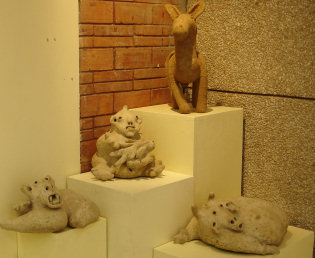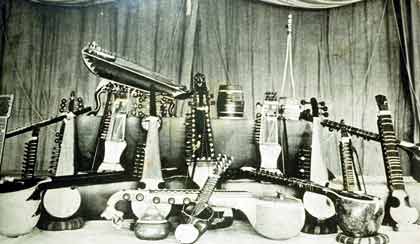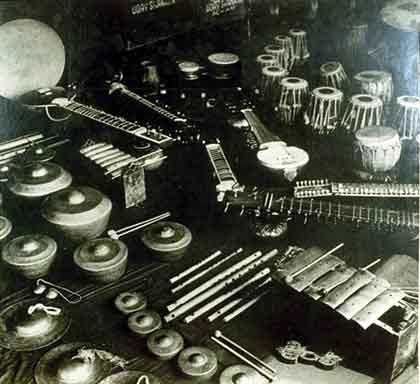Contemporary Problems for Indian Music

Contemporary Problems for Indian Music |
 |
By Dr. Lalmani Misra |

Art is that central alleyway which runs between the pacific ocean of truth on one side and the charming mirage of falsity on the other. Through his art the artiste sees both the worlds and experiences both vicariously. When in the lap of truth his heart unsullied by any attraction is filled with blissful waves of content and peace; under the force of falsity the heart fills up with fascination and he is enticed into the world of desire and allure. If the artiste’s heart stumbles on to the latter, he loses sovereignty of his existence, only to create history; whereas the artiste staunch on path of truth can never create it.
Having entered the false world, he creates a fictitious history and through this counterfeit creation he searches for truth and motivates other to experience truth. Having lost his power of sovereignty he is now subservient to the powers of the false world. The main powers that govern the world of sham existence (also called the practical world) are two – religion and politics. Both these powers, singly or in unison affect the artiste and his art. So absolute is their impact that we can not evaluate the art of any nation without studying its religious and political history. What causes the difference between development of music in India and in Europe – or that between cultural development of such places as Africa, China or Latin America? Development on natural principles presents itself through some special gifted individual at one time or another depending on the natural conditions during given age in any country. But the conscious development depends on the political affairs and religion of that country. Its curve of change swells or wanes with the various chapters in these two historical imperatives. Art rises or falters with the change in society. It is beyond the powers of individuals to ensure the survival or growth of any particular form of art. It well may get lost to all posterity. However, the art that nurtured in response to a particular natural feeling or desire is sure to resurface, even so in a new and different form. This perplexing principle of nature is unalterable.
Relying on this principle several people conclude that the modern orchestra is a hackneyed form of ancient Indian orchestra. Several others believe that it developed in Europe. Not until the ancient writings are fully explored, the truth shall never be established. If we concede to the opinion of nationalist zealots, the natural query would be regarding its original form. What were its underlying principles and why did it sink into oblivion? How is the orchestra that we proclaim to be Indian stands in relation to the ancient orchestra? I don’t suppose many people today would be concerned about seeking solutions to such significant problems when orchestration holds a major position in music, and on the basis of which, the Western music can assume a condescending stance to the rest. A complaisant Indian would discover on reaching Europe, America or Russia that how important is seeking solutions to such issues. He would rue the unconcern that kept the Indians from keeping links to their roots; for lack of such study we can not present before the world a traditional form of Indian orchestration. While we continue to bask in the praise world showers on our ancient culture, art forms and pride the way Indians living in various parts of the globe can still honour their ancient heritage, the glory and respect we enjoy shall gradually fade if we can not resolve the quandary and predicaments of our culture and art. I implore, with a brief submission, all those scholars and philosophers keen to claim glory and honour for India in the area of art and culture to focus their attention on solving such questions.
My conjecture is that orchestration took roots thousands of years back with people trying to play the melody of folk songs, often during festivals, on one and more instruments. However, this primary form could not develop much further, because vocalisation of a song is always more popular. Due the religious influence on Indian music, it always held state of Nirvana as its ultimate aim along with a desire to please the singer’s god; hence, there always has been a lack of creation and promotion of instruments. The only possible platform for orchestration was drama. Drama brought orchestra quite near its developed form as is apparent from following shloka-s of Bharat’s Natya Shastra.
Natyashastra is primarily a treatise on drama, therefore it contains discourse on things relevant to drama; thus discussion on music is quite limited. However this reference is enough to point to the development of music and evince the level to which orchestration had developed in India. Despite the possibility of variation in growth of orchestra during and Bharat period and later, by using the word “Kutup” for orchestra Bharat has established the independent existence of orchestra in his times.  Quite like description of Raga and Gati being made by Bharat, yet without clear indications of the notes used, Bharat has mentioned four categories of instruments but not named them, nor is the fact of orchestra being performed independent of drama mentioned in Natyashastra. What Saptaka-s were used; what was the methodology of playing? What swar-samvada (consonant notes) were used? What were the principles for creation of different Rasa-s? None of these could be ascertained. I know not of any text apart from Natyashastra that speaks about orchestra. So, at best, we can state that we had a sufficiently developed tradition of orchestration, but being limited to drama, without any independent musical existence it faded along with ancient Sanskrit theatre. Still later, there was no mention of orchestration from Moghul period to British dominion. Ever since their control over India in nineteenth century, the English introduced their culture and values which gradually obviated Indian practices. The Resident posted in every princely state by the British, apart from exerting political control steeped the members of royalty in niceties of European culture often arranging their trips abroad. Many scions and rulers visited England to get civilised and Paris to learn manners, spending money earned by back-breaking labour of their farmers and returned back exuding ecstasy as if they had visited paradise. A few of the wiser princes truly gained from their visits and tried to improve their local conditions. Some of the Nawabs and Rajahs moved by western music planned for an orchestra in their home-lands and on return ordered their music maestros to create one. Plays in Bangla, Marathi and Hindi too were being performed on a regular basis and this too helped formation of orchestral groups. The forgotten art of orchestration resurfaced in India in this manner. I don’t think this resurgence is over a hundred years today. True orchestration was practised by those formed on orders of rulers, because the secondary nature of those in drama troupes did not allow for an independent growth.
Quite like description of Raga and Gati being made by Bharat, yet without clear indications of the notes used, Bharat has mentioned four categories of instruments but not named them, nor is the fact of orchestra being performed independent of drama mentioned in Natyashastra. What Saptaka-s were used; what was the methodology of playing? What swar-samvada (consonant notes) were used? What were the principles for creation of different Rasa-s? None of these could be ascertained. I know not of any text apart from Natyashastra that speaks about orchestra. So, at best, we can state that we had a sufficiently developed tradition of orchestration, but being limited to drama, without any independent musical existence it faded along with ancient Sanskrit theatre. Still later, there was no mention of orchestration from Moghul period to British dominion. Ever since their control over India in nineteenth century, the English introduced their culture and values which gradually obviated Indian practices. The Resident posted in every princely state by the British, apart from exerting political control steeped the members of royalty in niceties of European culture often arranging their trips abroad. Many scions and rulers visited England to get civilised and Paris to learn manners, spending money earned by back-breaking labour of their farmers and returned back exuding ecstasy as if they had visited paradise. A few of the wiser princes truly gained from their visits and tried to improve their local conditions. Some of the Nawabs and Rajahs moved by western music planned for an orchestra in their home-lands and on return ordered their music maestros to create one. Plays in Bangla, Marathi and Hindi too were being performed on a regular basis and this too helped formation of orchestral groups. The forgotten art of orchestration resurfaced in India in this manner. I don’t think this resurgence is over a hundred years today. True orchestration was practised by those formed on orders of rulers, because the secondary nature of those in drama troupes did not allow for an independent growth.
Orchestration under the supervision of court musicians too had a skewed growth as these musicians knew very little about this art, never having travelled abroad to hear an orchestra. So, in place of creating individual and group phrases the local musicians played classical songs that were popular among singers. Such melodies required support of some Raga and both the refrain and stanza were played in unison before and after an imaginary Alap played solo on the main instrument. As Alap finished the group took up the refrain or the stanza. This was the initial form of the modern Indian orchestra.
While the orchestra reached its zenith in the world during eighteenth and nineteenth century the Indian orchestration without any guiding principles or style has little significance in twentieth century. Yet, nature gave birth to this art form again and the hope that endeavours by artistes in the future would embellish it seems justified.
For past two decades there have been reinvigorated attempts for orchestration. The lead being made by mature artistes, Indian orchestration is on its pathway to growth. Several new forms have come to the fore as a result of individual attempts and efforts made by various theatre companies. For the collectives’ efforts, the name of “New Alfred”, “Corinthian”, “Madan” and theatrical companies of Maharashtra, Jatra groups of Bengal, rulers of Baroda and Rampur can be named while amongst individuals, Vishnu Digmbar, Uday Shankar, Allauddin Khansaheb, Timir Baran and Shirali are prominent.
 While almost everyone believes in practice of Indian principles for orchestration, no one but Uday Shankar laid stress on use of Indian instruments alone for this purpose. Some may also point that even Uday Shankar troupe uses instruments from Burma, Java, Bali etc. They should comprehend that while in political terms India is a limited geographical entity today, in the past it included a far larger territory where religion and culture was concerned. We consider Colombo, Burma or even Karachi and Lahore as foreign places today while in our life-time we have considered them to be Indian cities. It is the adverse result of western politics that we have been dismembered so that we are forced consider our own land to be foreign now. However, culture can not fortunately be so easily dissected. The culture of parts forcefully separated from us shall ever bear evidence that that they belonged to us once. The worship of Rama and popularity of lore in places like Bali along with the mindset of people evinces that they were innately Indian places. So if we use Bali or Javanese instruments in Indian orchestration it is with complete sense of proprietorship as they have been lands sporting Indian culture. Using instruments from Burma, Colombo, Java, Sumatra, Singapore, Bali, Indonesia, Pakistan can not be labelled as use of foreign instruments. Thus Uday Shankar Troupe’s orchestra can be called an Indian orchestra, using innovations that bring Indian music to the fore.
While almost everyone believes in practice of Indian principles for orchestration, no one but Uday Shankar laid stress on use of Indian instruments alone for this purpose. Some may also point that even Uday Shankar troupe uses instruments from Burma, Java, Bali etc. They should comprehend that while in political terms India is a limited geographical entity today, in the past it included a far larger territory where religion and culture was concerned. We consider Colombo, Burma or even Karachi and Lahore as foreign places today while in our life-time we have considered them to be Indian cities. It is the adverse result of western politics that we have been dismembered so that we are forced consider our own land to be foreign now. However, culture can not fortunately be so easily dissected. The culture of parts forcefully separated from us shall ever bear evidence that that they belonged to us once. The worship of Rama and popularity of lore in places like Bali along with the mindset of people evinces that they were innately Indian places. So if we use Bali or Javanese instruments in Indian orchestration it is with complete sense of proprietorship as they have been lands sporting Indian culture. Using instruments from Burma, Colombo, Java, Sumatra, Singapore, Bali, Indonesia, Pakistan can not be labelled as use of foreign instruments. Thus Uday Shankar Troupe’s orchestra can be called an Indian orchestra, using innovations that bring Indian music to the fore.
Another orchestration inviting discussion is the one being used in films. Barring a few, most film melodies are take-offs on some Raga or village tune but the nature and manner of instruments used in orchestration admits quite a western impact. Despite a strong western influence even this form of orchestration is distinct from orchestra per-se. In saying this I don’t include those tunes or groups which are used to show a western situation or as accompaniment to ball-dances and suchlike. The remaining material of film music does evince a strong influence of Indian music but it does not adhere to Indian principles. But yes, it does seem geared to achieve the global norm of aesthetic sounds. In creating an Indian orchestra we should not shy of adapting this quality of Film orchestra.
Among the contemporaries, Uday Shankar troupe, S. Shirali, Ali Akbar Khan, Ravishankar, Shankar Rao Vyas, Timir Baran can be named for their contribution to modern Indian orchestration. Of these too, special mention can be made of Uday Shankar, Shirali and Ravishankar because besides having maturity, inclination, experience for making innovations in orchestration these artistes are also blessed with opportunity and necessary cooperation. The responsibility of establishing and guiding the innovation of Indian orchestra lies on such artistes. A person, who understands the importance of orchestral music in life, can not express satisfaction at the pace of its growth in our country. Of the various genres of music, orchestra is one that can accord the greatest pleasure to both the discerning and the lay person; therefore more and more music experts and lovers should work in this direction. We shall thus equip our music in the area, which in west is considered to be of extreme practical importance. It would be meet to keep the following points in mind while trying to create a tradition of Indian orchestration.
If a few of the music experts, practitioners and scholars ruminate on these lines and make individual and collective efforts to expound an adequate base, Indian orchestration would soon acquire a unique identity and occupy a place of glory in music genres of the world. I am sure endeavours of Indian musicians in this area would be successful and create a new philosophy in music that shall earn them a place in the world history.

Note by Editor:
This article was written by Dr. Misra on request of the editor of Sangeet Kala Vihar and published in the December 1952-January 1953 issue of the journal.
1: That Dr. Misra practised what he professed is proved by his mammoth work on Indian Musical instruments which was published two decades after publication of this article in 1973 by Bharatiya Jnanpith.
References :
Excerpts from Bharatiya Sangeet Vadya -- Dr. Lalmani Misra
Time Theory of Raga-s -- Dr. Lalmani Misra
Points to Ponder: Some Do’s for Musicians -- Dr. Lalmani Misra
Dr. Misra and I -- Nancy Nalbandian
Shruti Veena: Manifestation of Bharat’s Gram and ChatuhSarana -- Dr. Lalmani Misra
Forging Notes -- Maihar Band -- Rajiv Trivedi